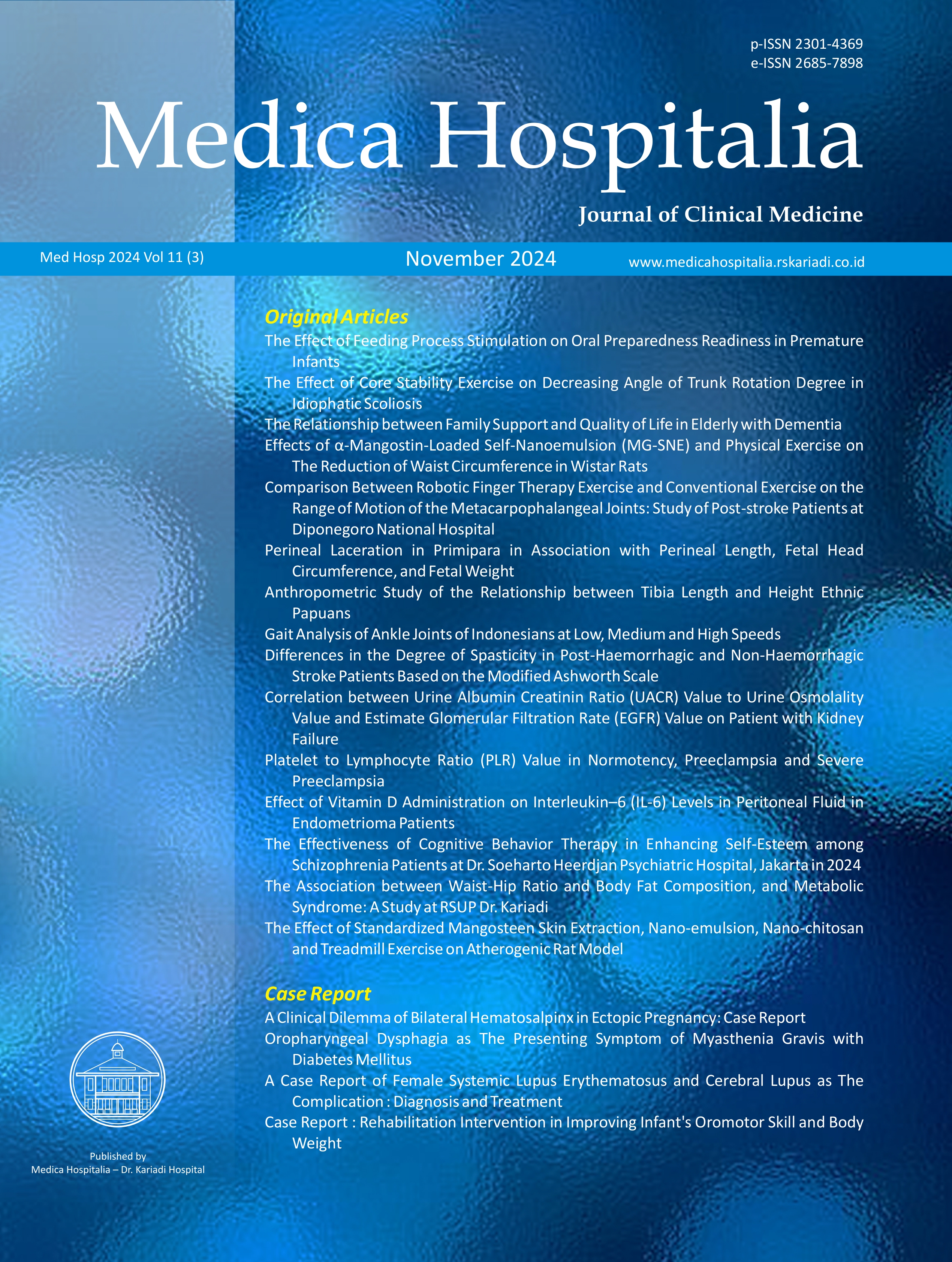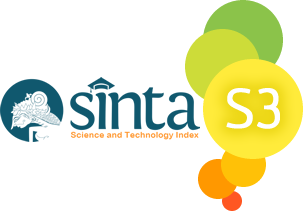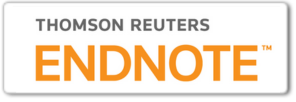Analysis of Risk Factors for The Severity of Hyaline Membrane Disease in Preterm Infants Based on Modality Chest X-Ray
DOI:
https://doi.org/10.36408/mhjcm.v12i1.1283Keywords:
Risk Factors, Hyaline Membrane Disease, Chest X-Ray, Premature InfantAbstract
BACKGROUND : Hyaline membrane disease is one of the leading causes of morbidity and mortality in premature infants. Chest X-ray examination can significantly improve the diagnosis of hyaline membrane disease.
AIMS : This study aims to examine the relationship between risk factors and the severity of hyaline membrane disease using chest X-ray modalities.
METHOD : An analytic observational study with a cross sectional and retrospective approach was conducted. Consecutive sampling of 30 preterm infants’s medical records and thoracic X-ray at Dr. Kariadi Hospital Semarang was used. Data collection was carried out from April to July 2023. Statistical tests included the Contingency Coefficient Correlation Test and Intraclass Correlation Coefficient (ICC).
RESULT : Findings indicate that HMD severity is associated with lower birth weights (p = 0.020; r = 0.392); gestational ages (p = 0.011; r = 0.420) and maternal hypertension (p = 0.013; r = 0.414). Preeclampsia, delivery method, and gender not significantly related to the HMD severity (p>0.05).
CONCLUSION : Infant birth weight, gestational age, and maternal hypertension are significantly associated with the severity of hyalin membrane disease.
Downloads
References
1. Diamane Ndour D. Diagnostic and Management of Hyaline Membrane Disease. 2018;8:810–9.
2. Military C, Malir H. Prevalense And Etiology of Respiratory Distress In Newborns. 2013;63(1):22–5.
3. Fareeda Wasfy B, Oday J, Adnan D. High Prevalence of Neonatal Respiratory Distress and its Possible Etiologies in NICU in Syria. Int J Pediatr Res. 2022;8(2):8–10.
4. Kommawar A, Borkar R, Vagha J, Lakhkar B, Meshram R, Taksandae A. Study of respiratory distress in newborn. Int J Contemp Pediatr. 2017;4(2):490.
5. Palod PH, Lawate BB, Sonar MN, Bajaj SP. A study of clinical profile of neonates with respiratory distress and predictors of their survival admitted in neonatal intensive care unit of tertiary care hospital. Int J Contemp Pediatr. 2017;4(6):2027.
6. Adebami OJ, Joel-Medewase VI, Agelebe E, Ayeni TO, Kayode O V., Odeyemi OA, et al. Determinants of outcome in newborns with respiratory distress in Osogbo, Nigeria. Int J Res Med Sci. 2017;5(4):1487.
7. Hameed Ajeli M AL, Shukr M, Abd AL-Hassin Hachim B. Original paper Prevalence and Etiology of Respiratory Distress in Newborns in the Fallujah Teaching Hospital for Women and Children. Karbala J Med. 2019;12(2):2199–202.
8. Lamichhane A, Panthee K, Gurung S. Clinical Profile of Neonates with Respiratory Distress in a Tertiary Care Hospital. JNMA J Nepal Med Assoc. 2019;57(220):412–5.
9. Minuye Birihane B, Alebachew Bayih W, Yeshambel Alemu A, Belay DM, Demis A. The burden of hyaline membrane disease, mortality and its determinant factors among preterm neonates admitted at Debre Tabor General Hospital, North Central Ethiopia: A retrospective follow up study. PLoS One [Internet]. 2021;16(3):e0249365. Available from: http://dx.doi.org/10.1371/journal.pone.0249365
10. Cheung WP, Wong KC, Mak WS, Kwong CYY, Kan EYL. Medical pulmonary diseases that cause neonatal respiratory distress: A radiological pictorial essay. Hong Kong J Radiol. 2020;23(1):57–65.
11. Hiles M, Culpan AM, Watts C, Munyombwe T, Wolstenhulme S. Neonatal respiratory distress syndrome: Chest X-ray or lung ultrasound? A systematic review. Ultrasound. 2017;25(2):80–91.
12. Yoon HK. Interpretation of Neonatal Chest Radiography. J Korean Soc Radiol. 2016;74(5):279.
13. Pasic I, Terzic S, Nisandzic J, Pokrajac D. Lung ultrasound and neonatal respiratory distress syndrome. J Clin Neonatol. 2020;9(4):272.
14. El-Malah HEDGM, Hany S, Mahmoud MK, Ali AM. Lung ultrasonography in evaluation of neonatal respiratory distress syndrome. Egypt J Radiol Nucl Med. 2015;46(2):469–74.
15. Brier J, lia dwi jayanti. Gambaran Foto Toraks Penyakit Membran Hyalin Pada Neonatus Di Rsup Wahidin Sudirohusodo Makassar Tahun 2018/2019. 2020;21(1):1–9. Available from: http://journal.um-surabaya.ac.id/index.php/JKM/article/view/2203
16. Melamed N, Klinger G, Tenenbaum-gavish K. Spontaneous , Singleton , Late Preterm. 2009;114(2):253–60.
17. Aslamzai M, Froogh BA, Mukhlis AH, Faizi OA, Sajid SA, Hakimi Z. Factors associated with respiratory distress syndrome in preterm neonates admitted to a tertiary hospital in Kabul city: A retrospective cross-sectional study. Glob Pediatr [Internet]. 2023;3(September 2022):100035. Available from: https://doi.org/10.1016/j.gpeds.2023.100035
18. McPherson C, Wambach JA. Prevention and treatment of respiratory distress syndrome in preterm neonates. Neonatal Netw. 2018;37(3):169–77.
19. Pickerd N, Kotecha S. Pathophysiology of respiratory distress syndrome. Paediatr Child Health (Oxford) [Internet]. 2009;19(4):153–7. Available from: http://dx.doi.org/10.1016/j.paed.2008.12.010
20. Condò V, Cipriani S, Colnaghi M, Bellù R, Zanini R, Bulfoni C, et al. Neonatal respiratory distress syndrome: are risk factors the same in preterm and term infants? J Matern Neonatal Med. 2017;30(11):1267–72.
21. Wang J, Yan J, Han J, Ning Y, Yan C. Risk factors for respiratory distress syndrome among Chinese infants of 34-42 weeks gestational age: a multi-center observational study. Int J Clin Exp Med. 2019;12(4):34–42.
22. Efriza E. Gambaran Faktor Risiko Respiratory Distress Syndrome Pada Neonatus Di Rsup Dr M. Djamil Padang. Heal J Inov Ris Ilmu Kesehat. 2022;1(2):73–80.
Additional Files
Published
How to Cite
Issue
Section
Citation Check
License
Copyright (c) 2025 Aulia Kusuma Dewi, Farah Hendara Ningrum, Adhie Nur Radityo Suswihardhyono, Lydia Widyastuti Setjadiningrat Kuntjoro (Author)

This work is licensed under a Creative Commons Attribution-ShareAlike 4.0 International License.
Copyrights Notice
Copyrights:
Researchers publishing manuscrips at Medica Hospitalis: Journal of Clinical Medicine agree with regulations as follow:
Copyrights of each article belong to researchers, and it is likewise the patent rights
Researchers admit that Medica Hospitalia: Journal of Clinical Medicine has the right of first publication
Researchers may submit manuscripts separately, manage non exclusive distribution of published manuscripts into other versions (such as: being sent to researchers’ institutional repository, publication in the books, etc), admitting that manuscripts have been firstly published at Medica Hospitalia: Journal of Clinical Medicine
License:
Medica Hospitalia: Journal of Clinical Medicine is disseminated based on provisions of Creative Common Attribution-Share Alike 4.0 Internasional It allows individuals to duplicate and disseminate manuscripts in any formats, to alter, compose and make derivatives of manuscripts for any purpose. You are not allowed to use manuscripts for commercial purposes. You should properly acknowledge, reference links, and state that alterations have been made. You can do so in proper ways, but it does not hint that the licensors support you or your usage.
























